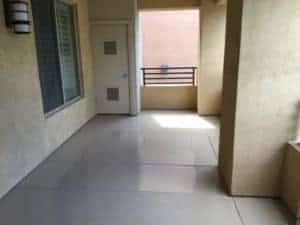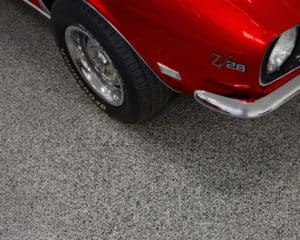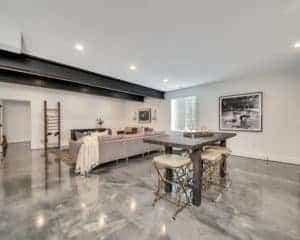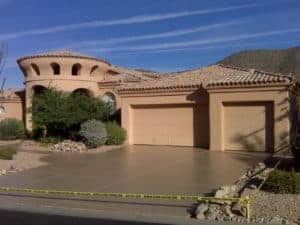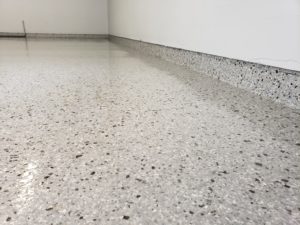In this blog, we discuss how multiple coats of one or more floor coating products – epoxy, polyurethane, polyurea-polyaspartic – are used in combination to produce a floor “coating systems”. Coating systems, once applied to concrete, produce the beautiful and durable flooring that customers desire.
Types of Coating Systems
Coating systems tend to fall into one of 3 categories:
- Solid color (“seamless”) – 8 to 12 mils in thickness
- Flake (Partial “flake”: 15 to 18 mils or full “flake”: 28 – 32 mils)
- Metallic – 15 -32 mils in thickness
A “mil” is a unit of thickness (millage) equal to 1/1000 of an inch. Generally speaking, the higher the mils the more durable the floor.
Solid Color Coating Systems
Solid color (or “seamless”) coating systems are the classic coating systems that were very popular in the past. They provide no superfluous patterns or texture. Just a medium to high gloss finish in one of a many possible colors.
Because even the slightest concrete imperfection may show itself in this system, seamless coating systems are frequently installed in basements where the concrete is smooth. The beauty of this system is its simplicity and lower cost.
See our solid-color (“seamless”) coating system here: Classic
Flake Epoxy Flooring Coating Systems
In “flake” epoxy flooring coating systems, a PVA thermoplastic flake or natural mica flake are incorporated into the color coat in a medium, extra-heavy or “full-flake” spread. The flakes provide added color, contrast and texture not seen in the solid-color system. Because of this, minor concrete defects are disguised.
And because of the added PVA or mica media stone flakes and subsequent clear coats, these systems are as durable as they are aesthetically stunning. They can be installed indoors and out, for example, and have rapidly gained in popularity throughout the US. However, installation costs increase as you go from a standard PVA-flake coating system to a mica-media system.
See our PVA-flake coating systems here: Deluxe, Premium and Ultra
See our mica-media systems here: Diamond Effects, Stone Silicate, Bagari SE & Vintage Mica
Metallic Coating Systems
Metallic coating systems provide a 3-D marbled look with iridescent accents and are suited for areas where a real visual impact is desired. To obtain the marbled look, applicators use one of several methods to disperse the metallic pigments. Hence, the possible effects are only limited by the installer’s imagination. So no two floors ever look alike.
These systems are not recommended for garage or high-traffic areas. Because of the complexity of application, this flooring can be expensive. Kitchens, basements and family rooms are common areas for the installation of these systems.
See our metallic coating systems here: Liquid Minerals and Liquid Art
One Coating System Does Not Fit All
It is important to understand that any one coating system is not fit for use in all spaces. Why? Because the coating system selected for installation (and the coating products used within the system) depends upon multiple factors specific to the space and substrate being coated!
Many factors are to be considered. Substrate exposure to ultraviolet light (e.g., driveways). Substrate exposure to chemical stains (e.g., garages). Aesthetics, odor sensitivity, return to service duration and, of course, cost. Therefore, the type of coating system installed should be determined together by the customer and professional installer only after an evaluation of the space to be coated.
Concrete Preparation
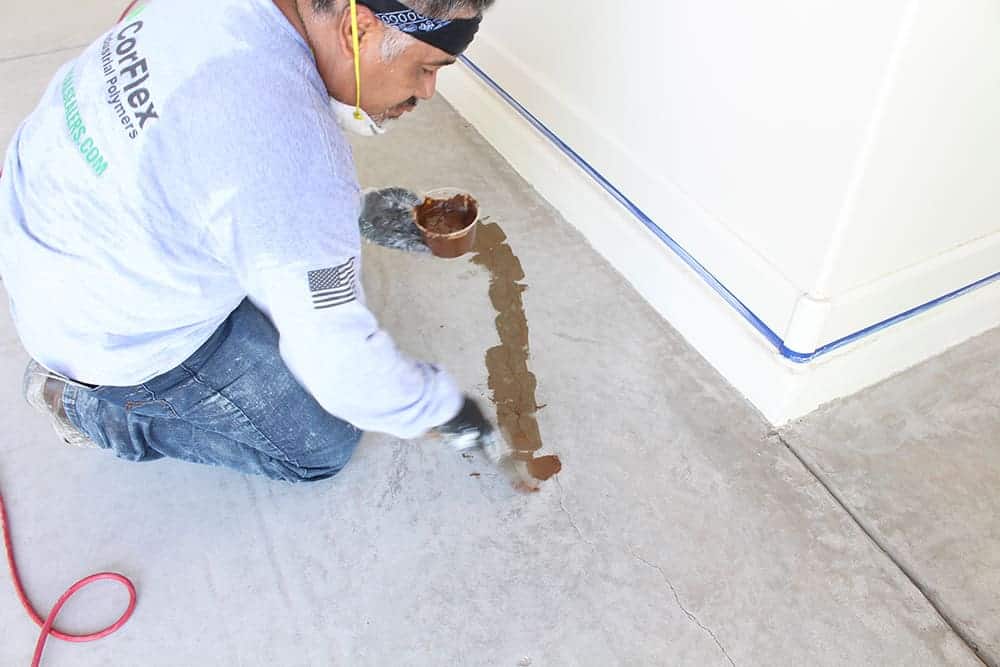
- Determining the percent moisture content of the concrete substrate.
- A Concrete Cure and Seal Test to determine if there is an existing coating (a curing agent, sealer or pigmented coating).
- Looking for existing contaminants in the concrete that may impact the appearance of the finished system.
Once these assessments are complete, final preparation of the substrate may begin. Typically this involves crack repairs, removal of contaminants, and grinding using powerful diamond grinders. The intent here is to produce a “profile” in the substrate that enables proper binding of the primer coat. An insufficient “profile” will lead to inadequate adhesion and lead to peeling of the coating system over time.
Coating & Flakes
Once substrate preparation is complete, only then does the application begin. The first step is application of the primer coat…a moisture-mitigating primer is the moisture is high. The primer is then topped with a color coat. In flake epoxy flooring systems, PVA or mica flakes are “broadcast” into the color coat and are topped with one or more clear coats.
As stated earlier, the choice of primer coat, color coat and topcoat are specific to the space being coated. For example, a space that is exposed to the sun or chemical staining (car oil, battery acid, tires) requires a different set of coating products than a space that’s not. Indoor spaces like basements require the use of low-odor products. High traffic areas, like hotel lobbies for example, require coating products with fast cure rates. Once again, these decisions must be assessed well before the first coat is ever applied.
Coating Systems: The Wrap
Understanding the advantages and disadvantages of each product type (epoxy, polyurethane, polyurea, and polyaspartic) is important. So is knowing how to use these products in combination. “Contractors” selling one-day installations don’t take these matters into consideration and the result is a poor quality flooring.
So if you are looking to install a long-lasting and durable floor coating, ask a professional contractor.
About the Author
Share this Post



